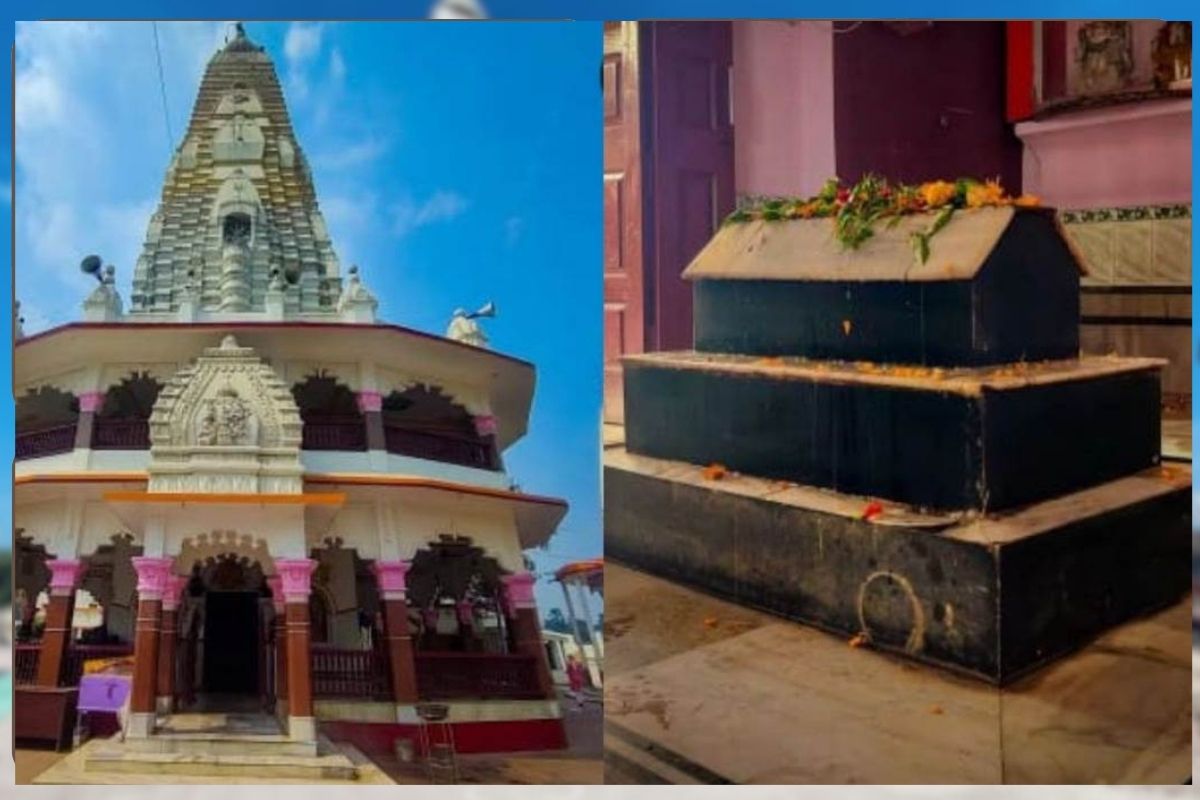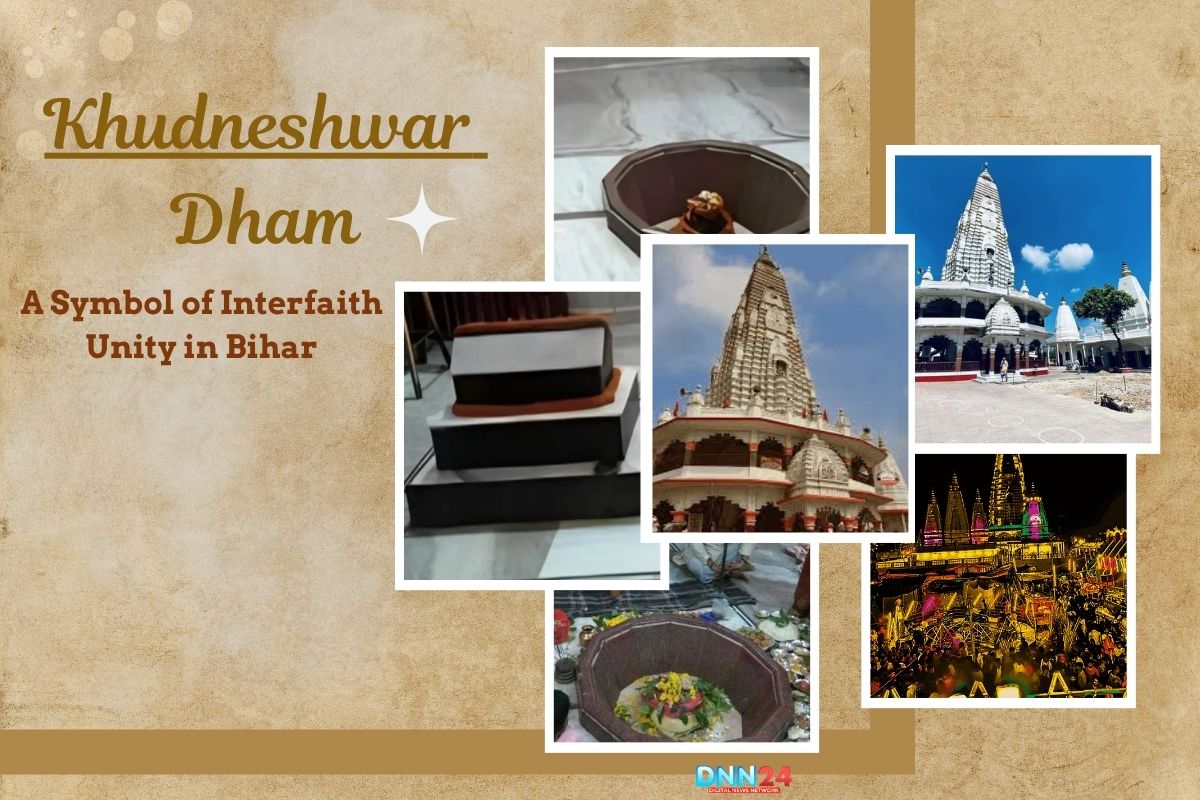There may be many tales about temples in India, but have you ever been to a place where a Shivling and a Muslim mazaar are worshipped under the same roof? Welcome to Khudneshwar Dham, situated in the Morwa block of Samastipur district, Bihar. This is not only a religious site, but it also represents the Indian tradition of unity in diversity. The central temple features a Shivling, to which devotees bring water and offer prayers according to Hindu rituals. Right behind it is the mazaar of Khudni Bibi, where people of different religions come to offer a chadar, light incense, and seek blessings.
This temple is believed to be centuries old, and thousands of devotees visit it annually. What is more special is the way Hindu and Muslim beliefs are combined in harmony. It is not a conflict but devotion. Here, people chant “Har Har Mahadev” and “Ya Khudni Bibi” in the same breath. The architecture is also rather peculiar: there is a Hindu temple with a Shivalinga in the front, and just behind it, a mazaar with a green dome.
This peaceful coexistence of two faiths is rare in today’s times, and Khudneshwar Dham stands as a glowing example of how spirituality can bring people together. Whether you are a devotee or a traveler, this place ensures that your heart is filled with devotion and your mind with peace.
The gripping tale of Mazaar of Khudni Bibi
Behind the powerful Shivling of Khudneshwar Dham lies an equally powerful story — the story of Khudni Bibi, a devout Muslim woman who unknowingly played a crucial role in revealing the presence of Lord Shiva. Local legends claim that Khudni Bibi resided in the nearby village and raised cattle in the area where the Shivling is now situated. Day after day, she observed one of her cows pouring milk in one place. She was wondering and dug the ground, finding a Shivling buried there.
This was a miracle, and it astonished all. The village elders regarded the place as sacred and chose to erect a temple around it. The people of the village wished to honour Khudni Bibi because she was the one who found it. Her mazaar was constructed at the very back of the Shivling after her death, and since then, both are still worshipped together. It is believed that Khudni Bibi was selected by Lord Shiva himself so that he could make his presence known to the world.

It is a touching story that is not a myth; however, the temple rituals keep the story alive. Devotees visit the shrine, first praying to the Shivling, and then see the tomb of Khudni Bibi, located behind the sanctum. This is a sign of faith that is being transferred through generations. It reminds us that devotion is not based on religion, and God can be present in anyone, regardless of their faith, whether Hindu or Muslim.
This story makes Khudneshwar Dham not just a temple, but a living example of India’s soul — where stories of love, faith, and unity bloom together.
Why do Pilgrims Flock here in Sawan, Shivratri, and Basant Panchami?
The atmosphere at Khudneshwar Dham turns magical during Sawan, Mahashivratri, and Basant Panchami. These festivals introduce a divine spirit into the temple, and devotees come to worship, not only in Bihar but also in other states. In the month of Sawan, the whole month is regarded as very auspicious to Lord Shiva. The devotees, usually dressed in saffron, walk barefoot and bring the holy water of the Ganga or the local rivers to pour it on the Shivling. They sing ‘Bol Bam’ and then walk miles to catch a glimpse of Baba Khudneshwar.
Another significant day is Mahashivratri, which is considered the marriage night of Lord Shiva and Goddess Parvati. During the evening, the temple remains open throughout the night, and the repetition of Om Namah Shivaya chants, bhajans, and offerings continues. Milk, honey, and ghee are poured on the Shivling. Immediately after this, the mazaar of Khudni Bibi is also visited by many people who offer chadar, and lamps are lit.
Basant Panchami, which is primarily associated with Saraswati Puja, is also joyously celebrated here. The air is filled with positivity, featuring yellow flowers, sweets, and kites. Both Hindu and Muslim people come here without any conflict. These festivals are not only religious to many people but also serve as an emotional means to reconnect with spirituality.
Not the number of visitors is a unique thing, but the peaceful and respectful celebration of two different religions in one place. What religion do you have here? Nobody questions; all they want is for you to worship with a clean heart.
How Devotees Express Their Faith at Khudneshwar Dham
Devotion at Khudneshwar Dham takes many beautiful forms. Some come here with mantras (wishes) — such as passing an exam, curing a family member, or finding a good life partner. They offer milk, water, and bael leaves to the Shivling, while others tie threads or put locks close to the mazaar so that their wishes can come true. Most newly married couples also come here to receive blessings for a happy married life.
The harmony of religions is one of the most touching things. You will observe a Hindu lady placing a diya in front of the Shivling and silently offering flowers at the mazaar. A Muslim man can bow humbly to the mazaar and afterwards provide water at the Shivling. It has no caste and creed, but faith and unity.

The priests and the temple keepers are also a symbol of this spirit of inclusion. They are welcoming to individuals, whether you are a regular visitor or a tourist. The temple authorities ensure that all people, regardless of their religion, have a peaceful darshan. The volunteers from both communities participate in crowd management, cleaning, and distributing prasad during the festivals.
Khudneshwar Dham is not just about religious practice — it’s about a way of living together, praying together, and believing together. In the present polarized world, such locations make us think that religion can still be used to make people come together and not apart.
Conclusion: Khudneshwar Dham — A Symbol of India’s Shared Spiritual Heritage
Khudneshwar Dham is not just a temple or a mazaar — it is a living example of India’s Ganga-Jamuni tehzeeb, where unity, respect, and love flow like sacred rivers. When events of religious differences become a regular front-page news, this holy place in Samastipur speaks instead of a story of oneness, in silence. Whether you are Hindu, Muslim, or from any faith, Khudneshwar Dham welcomes you with open arms. So next time you hear about a place of worship, remember Khudneshwar Dham — where Shiva and Khudni Bibi bless devotees together under one sky.
Also Read: Ramayana in Bollywood: A Cinematic Journey Through the Epic
You can connect with DNN24 on Facebook, Twitter, and Instagram and subscribe to our YouTube channel.

